Chevron Richmond Refinery
The Chevron Richmond Refinery is a 2,900-acre (1,200 ha) petroleum refinery in Richmond, California, on San Francisco Bay.[1] It is owned and operated by Chevron Corporation and employs more than 1,200 workers,[1] making it the city's largest employer.[2] The refinery processes approximately 240,000 barrels (38,000 m3) of crude oil a day in the manufacture of petroleum products and other chemicals. The refinery's primary products are motor gasoline, jet fuel, diesel fuel and lubricants.[3]
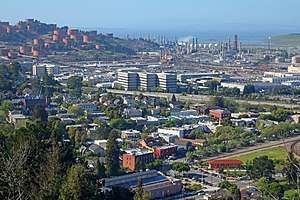 Image showing the refinery and the marshlands in the background; Point Richmond in the foreground. | |
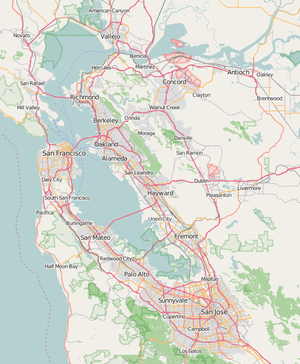 Location of the Chevron Richmond Refinery in California  Chevron Richmond Refinery (California)  Chevron Richmond Refinery (the United States) | |
| Country | United States |
|---|---|
| City | Richmond, California |
| Coordinates | 37°56′32″N 122°23′43″W |
| Refinery details | |
| Owner(s) | Chevron Corporation |
| Commissioned | 1902 |
| Capacity | 240,000 bbl/d (38,000 m3/d) |
| No. of employees | 1,200 |
History
Beginnings
The refinery was established several years before the City of Richmond was incorporated in 1905. Construction on the refinery began in 1901 between the Potrero Hills and the marshlands in the Point Richmond District; the refinery was opened in 1902.[4] The refinery was built by Standard Oil and its first headquarters was in an abandoned farm house at the former site of the Peters and Silva Farms.[5] The complex was described as "colossal" at the time and to this day it remains a very large complex of its kind.[4] In its first year of operation the plant could process 10,000 barrels (1,600 m3) of oil per day and had a tankage capacity of 185,000 barrels (29,400 m3) in that same first year.[4] William Rheem played a key role in the facility's construction[5] and implementation, being the project manager and the installation's first superintendent.[4] Furthermore, Rheem continued on to be a key and historic civic figure in the City of Richmond. The presence of the burgeoning refinery transformed the small town of Richmond from a rural agricultural community with 200 residents to a company town of several thousand within a few years.[4]
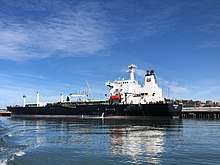
Crude oil is delivered by, and refined products distributed by, oil tankers using a long wharf extending into San Francisco Bay. Pipe lines connect the wharf to the refinery; and a parallel 42-inch (1.1 m) narrow gauge electric railway was built to transport packaged goods, shipboard supplies and personnel. The refinery shops built six power cars and three unpowered trailers for use under 2.25 miles (3.62 km) of overhead line. Trolley operation began in 1905 serving a shipside hotel, ship chandlery, shook factory, barrel works, and some refinery administration offices. The trolley line was replaced by trucks and buses in 1948.[6]
Growth
The number of passenger cars in the United States rose from 1.6 million to 5.6 million from 1914 to 1918. Motor trucks, farm tractors, and aircraft all increased at a comparable rate. As a result, the demand for gasoline, lubricants and other petroleum products intensified.[7] The Richmond refinery was in an excellent position with its plentiful crude oil, state-of-art equipment and prime location to capitalize on the increased demand for petroleum products on the West Coast. By 1915, the refinery spread across 435 acres (176 ha), employed 1,700 workers, and had a capacity of 60,000 barrels (9,500 m3) a day. Not only did the refinery produce transportation fuels, it also had a grease plant, an asphaltum plant, a can factory, a barrel works, a machine shop and a tank car repair shop.[7]
When the United States entered World War I in 1917, the Richmond refinery became a critical producer of fuel for trucks, tankers, trains, and planes in the war effort. Historian Gerald White reported that the "high quality of the medicinal white oil developed at Richmond to take the place of Russian white oil, cut off by the war, caused an executive of E.R. Squibb & Sons to comment that the Richmond product was 'superior to the best oil' ever imported." [7]
At the end of the war the company shifted its focus back to basic product research and in 1919 constructed a well-equipped red brick laboratory building that still stands today. Development manager Ralph A. Halloran's emphasis on centralized, systematic research helped the department gain greater prestige in support of the company's tenet, "Research First - Then Advertising," which ensured that a product was thoroughly tested before being introduced to the public. By 1924, the laboratory's staff grew to 75 skilled employees, who engaged in tests and experiments, not only to develop new uses for petroleum, but to improve existing processes.[7] In 1938 the refinery constructed a new Hydro Plant for the production of synthetic aviation gasoline. It was the first in the Western United States to produce synthetic gasoline by combining purified hydrogen gas with an unsaturated gas by-product from gasoline cracking operations.
With the onset of World War II the refinery saw major changes. Many employees left for service in the U.S. military and close to 400 women joined the refinery workforce. The refinery shifted production to high-octane fuel and other products to meet military needs. In 1943 a toluene plant was constructed to supply the key ingredient for TNT and later, at the request of the U.S. military, was converted to production of 100-octane gasoline. The U.S. Secretaries of War and Navy and the Petroleum Administrator commended the refinery for exceeding the production of aviation gasoline requested by the government. In 1945, the Richmond refinery won its fifth U.S. Army-Navy "E" award for its support of the military effort.[7]
Present Day Refinery
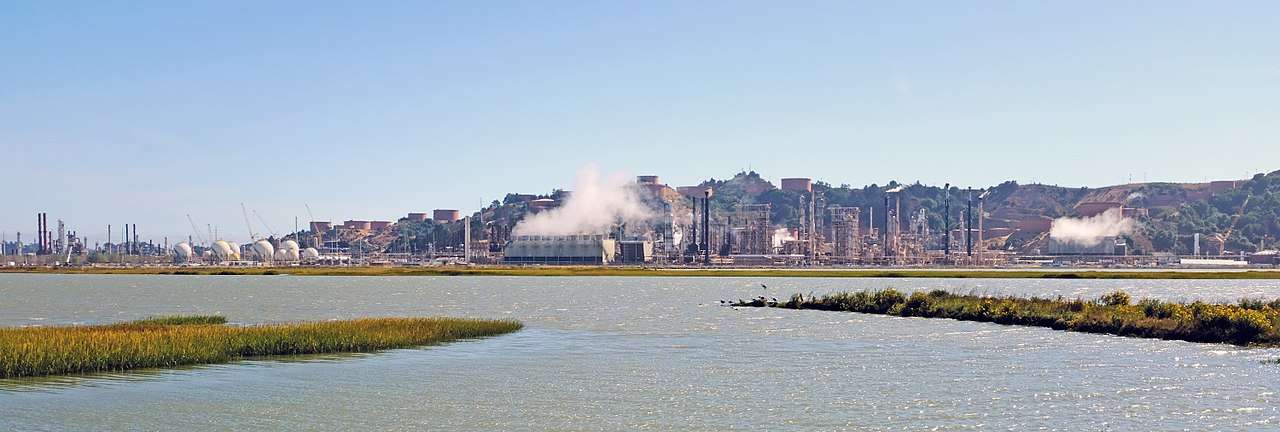
Modernization

Following the end of World War II, the refinery began a long-range modernization and expansion of its facilities to accommodate the new post-war consumer demands for petroleum products. The refinery constructed units that increased production of highly refined products for the postwar generation of higher-compression engines. In 1951, a 50,000-barrel (7,900 m3) residuum stripper was constructed to convert heavy residual fuel oil into lighter products. In 1959, the company made a major breakthrough when it developed the Isocracking process which uses catalysts to rearrange the existing molecules of heavy fuel oils to remove sulfur and convert low-value fuel oils into higher-yield products such as gasoline. The company also completed a new fluid catalytic cracking unit capable of processing 40,000 barrels (6,400 m3) daily of feed stock, further adding to the high-octane gasolines being demanded in rapidly increasing quantities by modern, high-compression automobile engines. In 1965, a breakthrough came when the Richmond refinery opened the world's largest Isomax hydrocracking complex. The unit converts heavy petroleum oils to lighter stocks for gasoline and other higher valued products. The 62,000-barrel (9,900 m3)-a-day unit increased the plant's gasoline output by 40%. A solvent de-asphalting plant and a hydrogen manufacturing plant were also constructed to support the Isomax and were the largest of their kind ever constructed.[8]
The post-war years were also marked by a dramatic increase in demand for petrochemicals to serve as the building blocks for hundreds of essential consumer products. In 1951, a new unit was constructed to manufacture paraxylene, a basic material used for making synthetic fibers, and was the first of its kind to produce the chemical from petroleum. The West Coast's first phenol plant was completed in 1954 for the production of lubricating oil and lubricating oil additive, resins and plastic, and plywood adhesives. A year later, another chemical plant for the manufacture of isophthalic was constructed, the first in the US. Isophthalic is a chemical intermediate used in plastics and surface coatings. In 1960, construction began on a $17 million complex for production of para- and orthoxylenes, important chemical intermediates, at the Richmond refinery. Another major project increased the capacity for production of alpha olefins, used extensively in the manufacture of "soft" detergents, lubricant additives, plastics and plasticizers.[8] None of these chemical plants are still in operation today except for the alpha olefin plant, which produces an intermediate chemical for the production of Techron, Chevron's gasoline additive.
Recent history
During the 1970s and 1980s as the dynamics of the United States petroleum industry were changing, the refinery was transformed to produce higher-value, higher-volume fuels and lubricating oils and to comply with increasingly stringent state and federal policies. These policies called for the refinery to reduce air emissions and waste, treat water, and prevent oil spills.
In order to comply with federal mandates for reduced-lead gasoline the refinery installed reforming units in 1971 to produce higher octane gasoline material. In 1975, the refinery added a desulfurization unit for the production of low-sulfur fuel oil, primarily to supply the growing needs of California electric utility companies. The expansion was also designed to process greater quantities of high-sulfur crudes and products that met environmental specifications. During the expansion the refinery also built two 750,000-barrel (119,000 m3) storage tanks, the largest in the United States, to receive marine cargos.[9]
In 1979, a worldwide shortage of crude oil, along with a shift in the availability of quality crudes, presented challenges to manufacturing operations. Chevron invested in the Richmond refinery, improving their flexibility for handling different types of crude oil, responding to changing product standards, installing energy conservation equipment, and complying with environmental or regulatory requirements. A $17 million direct digital computer control system was first installed in the Isomax plant, and later expanded to include all plants.[9] This enabled the refinery to produce higher-grade products and reduce energy consumption.
In 1984, the construction of a major lubricating oil manufacturing plant increased Richmond's lube oil base-stock output from 3,800 to 8,500 barrels (1,350 m3) a day, using hydrocracking and hydrorefining processes developed by Chevron Research. Later, in 1993, a major research breakthrough occurred when Chevron introduced Isodewaxing technology.[9] This new technique maximized the production of high quality base oils while co-producing high-value light products and allowed for the economical production of base oils that meet specifications calling for lighter-viscosity lubricant grades.
During the 1990s the refinery began producing Chevron Plus Unleaded gasoline, which replaced regular leaded gasoline in California in 1992.[9] Methyl tert-butyl ether, or MTBE, was added as an oxygenate and to raise the octane number. However, MTBE was found to contaminate groundwater, and in 2004 was replaced with ethanol.[10]
In 2001 former vice mayor and councilman John Márquez stated that he did not think that the refinery's numerous toxic spills were intentional.[11] He also stated that he thought the refinery was safe.[11] He received campaign funding from BAPAC, that was backed by a $1,500 from Chevron Corporation.[11] Marquez also opposed measure T and the 16,000,000 dollars that it would bring the city from large industries like Chevron.[11]
In 2002, the 100th anniversary of the Richmond refinery, the plant had over 1,300 employees, covered 2,900 acres, operated 30 plants, and had the ability to move 340,000 barrels (54,000 m3) per day of raw materials and finished products across its long wharf. By 2006, the refinery had a capacity of 225,000 barrels (35,800 m3) a day and processed more crude oil than any other plant in the Bay Area and ranked among the major refineries in the U.S.[9]
In March 2014, the company launched a website to provide Richmond-area community news.[12]
Incidents
1989 explosion and fire
On April 10, 1989, an explosion and fire occurred in a cracking column at the refinery. A total of 8 workers and firefighters were injured.[13] Three workers suffered second and third degree burns. As a result, in September 1989 the Occupational Safety and Health Administration fined Chevron $877,000 for "willfully failing to provide protective equipment for employees."[14] Chevron employees had "repeatedly requested" protective equipment since the early 1980s but the company had refused despite more than 70 fires in the plant since 1984. Elizabeth Dole, the US Secretary of Labor, said: "OSHA's investigation makes clear that Chevron knew of the need for protective equipment and clothing for employees who, though not assigned to the fire brigade, were responsible for assisting firefighters in their unit."[15] Chevron lodged notices of contest against the penalties but in 1991 agreed to pay the U.S. Department of Labor $275,000 "in full financial settlement."[16]
1999 explosion and fire
On March 25, 1999, there was an explosion and fire at the refinery that spread noxious fumes and sent hundreds of Richmond residents to hospitals.[17] After the 1999 explosion, residue was left in nearby water sources and soil which affected many nearby residents. The explosion accidentally sent out sulfuric gases into the air, affecting many nearby communities. A "shelter in place" advisory was issued, but proved ineffective because many residents were non-English speakers and were not able to get the adequate info through local media or the English only safety procedures that were announced. Chevron and county health services lacked consistence of informing the residents about the importance to "shelter in place" in order to avoid inhalation of the harmful chemicals (over 200 chemicals) that were leaking into the communities.[18]
2012 fire
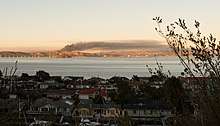
On August 6, 2012, a large fire erupted at the refinery at about 6:15 PM and reported to be contained at 10:40 PM.[19][20] Flames were seen issuing from at least two of the refinery's towers. Contra Costa Health Services responded by notifying residents shelter in place. BART shut down local service.[21] The shelter-in-place order was lifted at 11:15 PM.[20] Initial reports estimated that 11,000 people sought treatment at area hospitals,[22] and later reports placed the number above 15,000 people.[23]
Six employees that were present at the scene of the fire suffered varying degrees of injury. Employee 1 received a minor burn to a small area on the left ear, Employee 2 suffered a small burn to the left wrist, Employee 3 suffered from abdominal discomfort. Employee 4's respiratory pathway was irritated, Employee 5 suffered blistering to the right leg from boot wear, and Employee 6 had a bruised finger. All of the injured employees were given on site medical treatment by the Chevron Fire Department and other on site medical staff.[24]
A refinery spokeswoman stated that the fire erupted in the number 4 crude distillation unit, or CDU. Just before 6:30 p.m., an inspection crew discovered that there was a diesel leak in a line in the CDU—and that the leak was growing. The crew evacuated the area just before the diesel ignited, said Nigel Hearne, manager of the refinery.[21] Three refinery workers were given first aid at the refinery. On April 15, 2013, the US Chemical Safety Board released their preliminary report citing Chevron for a chronic failure to replace aging equipment and called for an overhaul of regulatory oversight of the industry to prevent such accidents from happening again.[25][26][27][28] In January 2015, the CSB released their final investigation report.[29]
Analysts predicted that the fire would cause an increase in gasoline prices in the western United States.[30] A Chevron spokesperson later said that the fire was one factor among others, including the price of crude oil, that influenced prices.[31] However, data collected by the California Energy Commission showed that increased production at other refineries more than made up for the Richmond loss, with 461,000 gallons of crude oil added to state refinery production during the week of August 3 through August 10, 2012.[31]
In 2013, the company pleaded no contest to six charges in connection with the fire, and agreed to pay $2 million in fines and restitution.[32] On the first anniversary of the fire, 210 people were arrested while marching to protest safety issues at the refinery.[23]
Around the same time the settlement was announced, the Richmond city council voted to file suit against Chevron. The reasons for the suit included "a continuation of years of neglect, lax oversight and corporate indifference to necessary safety inspection and repairs."[23]
2014 incident
On December 18, 2014, a flare event occurred. It was described by local television station KGO-TV channel 7 as a "large flare is producing flames".[33]
2016 incident
On September 3, 2016, black smoke could be seen coming from the refinery. NBC Bay Area reported that this was due to flaring.[34]
Environmental record
Source of crude
This refinery receives small quantities (relative to their other sources) of crude oil from the Amazon region of South America, according to the Borealis Centre for Environmental and Trade Research.[35]
Air quality monitoring
Chevron is currently implementing an Air Quality Monitoring program in the surrounding neighborhoods of North Richmond, Point Richmond and Atchison Village. This program is part of the Richmond Community Benefits Agreement (RCBA, Section 2.F(2))[36] for the Chevron Energy and Hydrogen Renewal Project. The Air Quality Monitoring Program will sample air quality using testing methods similar to those used by government agencies and publish these results on a community-accessible website.[37]
Some citizens routinely patrol the area with air collection bins to measure the chemical content of the air.[38]
Castro Cove
Between 1902 and 1987 the refinery released noxious chemicals into the surrounding environment with impunity.[39] This came in the form of contaminated process water from the industrial facilities of the complex. There are unhealthy levels of polycyclic aromatic hydrocarbons (PAHs) and mercury in the estuarine habitats of Castro Cove and the San Pablo Creek Marsh adjacent to the refinery's runoff from their waste water outfall. The water is highly toxic to wildlife and is too polluted for fishing, swimming, or wading.[39]
Since 1987 the refinery has reduced the impact of discharged process water by improving water treatment to reduce contaminants, including metals, by approximately 80 percent and reducing the amount of treated water discharged from 22 million US gallons (83,000 m3) to 5.6 million US gallons (21,000 m3). Additionally, in 1987 the refinery completed the deepwater discharge project moving the effluent discharge point from Castro Cove to deep water in San Pablo Bay to provide for greater dilution of remaining contaminants and minimize the impact on water quality.[40]
In 2007 and 2008, Chevron engaged in a clean-up operation of the cove that cost between $20 and $30 million after being ordered to do so by the California Regional Water Quality Control Board's Bay Protection and Toxic Clean-up Program (which found Chevron liable for an additional $2.85 million in "natural resources damages.")[41]
Controversies
Tax rates
In 2006 a local referendum (Measure T) proposed to raise the business tax. Chevron vehemently opposed the initiative and funded a massive flyer campaign, suggesting it would lead to evictions of seniors and closing of small businesses.[42] The measure failed by 54%. However, in 2008 the measure was revived, modified to tax only large manufacturers; it passed by 51.5%.[42]
Unpaid taxes
In 2009 the Chevron refinery agreed to pay the city of Richmond $28 million in back utility taxes.[43]
In 2011 Chevron unsuccessfully sued Contra Costa County for 73 million dollars claiming its property taxes were too high.[44][45] The company's lawyers stated that the refinery was not worth $3 billion in 2007 and 2009 as assessed, but instead only worth $1.8 and $1.15 billion respectively.[45] During the hearings, Gayle McLaughlin, Mayor of Richmond, stated "If Chevron wins this appeal, it will mean layoffs, major cutbacks in services and would push us virtually to the edge of bankruptcy. Cities are suffering and Chevron is making billions of dollars."[46] Kevin Lally, attorney acting for Richmond during the appeal, stated that Chevron had manipulated data, refused to give the assessor's staff necessary information, and falsely characterized the nature of the county's assessment process, stating that Chevron's analysis was "fraught with materials that don’t satisfy evidentiary standards.”[45][46] Around fifty protestors organized by the Richmond Progressive Alliance including Mayor McLaughlin and city council member Jovanka Beckels protested at the hearings, silently holding signs.[45]
The Assessment Appeals Board eventually found against Chevron's appeal, found that the county assessor had actually undervalued Chevron's refinery, and ordered Chevron to pay an additional $26.7 million in taxes, rather than receiving the $73 million refund Chevron sought.[44]
Bay Trail
A portion of the San Francisco Bay Trail from Point Molate through to Point San Pablo crosses oil pipelines that connect the Chevron refinery with the Richmond Long Wharf.[43][47] Chevron opposed the construction of this segment of the Bay Trail, citing security concerns, and stating that post-September 11 security requirements posed an issue.[47] Supporters of the Bay Trail along with then California Lieutenant Governor John Garamendi pushed Chevron into accepting the construction of the Bay Trail in exchange for allowing the company to renew its 30-year lease on state tidelands that lie at the site of its port.[47] In addition, the Richmond city council passed a resolution 8-1 directing mayor Gayle McLaughlin to ask the California State Land Use Commission to persuade Chevron to permit the trail.[1]
Chevron claimed that its total commitment in the Bay Trail amounted to $12.5 million, with $3 million being taken from Chevron's backtaxes, and $7.5 million worth of land being committed to the project.[43] A Chevron spokesperson stated that these numbers had been arrived at using Chevron assessors.[43] Bruce Beyaert, head of the Trails for Richmond Action Committee (and former Chevron environmental executive)[48] disagreed with Chevron's stated figures, saying that they were heavily inflated and amounted to "smoke and mirrors."[43] Beyaert pointed to a 2001 joint trail study finding the trail easement south of I-580 worth $280,000, not the three million dollars Chevron assessed it at.[43] Beyaert also states that there had previously been discussions to give land north of I-580 for free under an East Bay rails to trails project, land which Chevron's internal assessors valued at $4.5 million upon agreeing to the Bay Trail's construction.[43] The portion of the trail in question has since been completed.
Trade Secrets
In September 2014, the proponents of 1st Amendment free speech have argued against the bill SB130 allowing Chevron to maintain a degree of trade secrets that was said to have a potential to compromise operational safety.[49]
References
- Chevron Access Needed for Richmond Bay Trail Link, by Geneviève Duboscq, The Berkeley Daily Planet, 27-03-2007, access date 06-04-2009
- "City Facts. City of Richmond, California". Planning & Building Services Department. Retrieved January 31, 2017.
- What We Do: The Refining Process Archived June 14, 2009, at the Wayback Machine, Chevron website, access date 05-16-2009
- The Early Years 1902 - 1914 Archived 2009-09-02 at the Wayback Machine, Chevron website, access date 02-19-2009
- Chevron Beginnings: W.S. Rheem, by Nilda Rego, Contra Costa Times, 01-18-2009, access date 02-19-2009
- Ward, B.H. (1967). "Standard Oil Company of California". The Western Railroader. Francis A. Guido. 30 (332): 5&6.
- Growth Through Research and Innovation 1915 - 1945 Archived September 2, 2009, at the Wayback Machine, Chevron website, access date 05-16-2009
- Fueling the Peace and Protecting the Environment 1946 - 1970 Archived February 13, 2011, at the Wayback Machine, Chevron website, access date 02-19-2009
- Building a World-class Organization 1971 - Present Archived February 13, 2011, at the Wayback Machine, Chevron website, access date 05-16-2009
- Methyl tert-butyl ether, Wikipedia, access date 05-16-2009
- Richmond Debates Building Its Own Power Plant at the Chevron Refinery, Jennifer Barrios, 25-05-2001, access date 21-04-2012
- San Francisco Chronicle
- "EXPLOSION, FIRE AT CHEVRON REFINERY RESTRICT WEST COAST OIL PRODUCTION". The Boston Globe. Boston. April 12, 1989.
- Lee, Patrick (September 27, 1989). "Chevron Fined $877,000 for Refinery Fire". Los Angeles Times. Los Angeles. Retrieved December 15, 2015.
- "Chevron Fined for Its Failure To Equip Firefighting Workers". The Washington Post. Washington, D.C. September 27, 1989.
- "Settlement Agreement". Occupational Safety & Health Administration. March 6, 1991. Retrieved December 15, 2015.
- "Huge explosion rocks Richmond oil refinery". San Francisco Chronicle. March 26, 1999. Retrieved 8 August 2012.
- Scott, Rebecca R. (14 November 2012). "Laotian Daughters: Working toward Community, Belonging, and Environmental Justice by Bindi V. Shah". American Journal of Sociology. 118 (3): pgs. 838–840. doi:10.1086/667767.
- "Kristin J. Bender and Daniel M. Jimenez, "Massive fire at Chevron refinery in Richmond fully contained; shelter in place lifted", Contra Costa Times (August 6, 2012)". Archived from the original on September 29, 2013. Retrieved August 7, 2012.
- Bender, Kristin J.; Jimenez, Daniel M. (August 6, 2012). "Massive fire at Chevron refinery in Richmond fully contained; shelter in place lifted". San Jose Mercury News. Retrieved 8 August 2012.
- Justin Berton, Kevin Fagan and Vivian Ho, "Fire at Chevron refinery in Richmond: East Bay residents told to stay inside as thick smoke spews into sky from Chevron plant", SFGate, San Francisco Chronicle on line (August 7, 2012).
- Chevron refinery fire a 'close call', Jaxon Van Derbeken, San Francisco Chronicle, 20-08-2012, access date 21-08-2012
- "Chevron to Pay $2 Million for 2012 Refinery Fire in Richmond, CA; 200 Arrested at Protest". Democracy Now!. 6 August 2013. Retrieved 6 August 2013.
t was one year ago when a massive fire at a Chevron refinery in Richmond, California, sent toxic smoke billowing into the air about 10 miles northeast of San Francisco. In the aftermath, more than 15,000 people sought medical treatment for respiratory problems. On Monday, Chevron pleaded no contest to six criminal charges related to the fire and agreed to submit to additional oversight over the next few years and pay $2 million in fines and restitution as part of a plea deal with state and county prosecutors. Two days earlier, thousands of people marched to condemn safety issues at Chevron’s plant and to call for renewable alternatives to fossil fuels.
- "Sixth Update to the 30-Day Report for the CWS Level 3 Event of August 6, 2012" (PDF). Contra Costa Health Services. March 29, 2013. p. 4. Retrieved February 15, 2017.
- "Fire At Chevron Refinery, Shelter-in-Place Warning". Berkeley Patch. Archived from the original on 10 August 2012. Retrieved 7 August 2012.
- "Chevron Refinery Fire: Huge Blaze In Richmond Can Be Seen For Miles". Huff Post. 6 August 2012. Retrieved 7 August 2012.
- Luschek, Mathew. "Fire Erupts at Richmond, Calif., Refinery". NBC. Retrieved 7 August 2012.
- Rogers, Robert. "Richmond: Federal agency blames Chevron for refinery fire". Mercury News. Retrieved 15 April 2013.
- "Chevron_Final_Investigation_Report" (PDF). CSB.gov. Archived from the original (PDF) on 14 July 2015. Retrieved 21 July 2015.
- Collins, Terry (August 7, 2012). "Experts: Richmond fire will boost gas prices". Associated Press, cited by Monterey County Herald. Retrieved 8 August 2012.
- Tokar, Dylan (15 August 2012). "Gas prices increase after Richmond refinery fire". The Daily Californian. Retrieved 6 August 2013.
- "Chevron pays $2m fines and pleads no contest to Richmond fire charges". Associated Press report appearing in The Guardian. 5 August 2013. Retrieved 6 August 2013.
- "DEVELOPING: A large flare is producing flames at the Chevron refinery in Richmond. it can be spotted from miles away". Twitter. ABC7. 18 Dec 2014.
- "Black Smoke Rises From Chevron's Richmond Refinery". NBC Bay Area. Retrieved 2017-02-21.
- "From Well to Wheel: The Social, Environmental, and Climate Costs of Amazon Crude" (PDF). Amazon Watch. Retrieved 24 March 2017.
- Charter Document for the Richmond Community Benefits Advisory Committee, Richmond Community Benefits Advisory Committee, access date 05-16-2009
- Neighborhood Air Quality Monitoring Archived November 5, 2009, at the Wayback Machine, Chevron website, access date 05-16-2009
- Taking the Toxic Tour Archived November 21, 2008, at the Wayback Machine, Common Ground Magazine (note: contains inaccuracies), access date 05-16-2009
- Castro Cove/Chevron Richmond, CA Archived 2008-09-17 at the Wayback Machine, National Oceanic and Atmospheric Administration (NOAA), retrieved August 1, 2007
- Protecting Water Quality Archived February 1, 2009, at the Wayback Machine, Chevron website, access date 05-16-2009
- United States Department of Commerce (June 2010). Damage Assessment and Restoration Plan/Environmental Assessment (Report). Retrieved December 16, 2015.
- Historic local victory points the way forward Archived 2013-04-15 at Archive.today, by Bob Patenaude, People's Weekly World Newspaper, 19-02-2009, access date 19-02-2009
- Chevron, Richmond Strike $28 Million Deal for Refinery Utility Taxes, by Katherine Tam, Oakland Tribune, 18-02-2009, access date 19-02-2009
- Vorderbrueggen, Lisa (2 April 2012). "Chevron Loses Tax Appeal in Contra Costa County". Oakland Tribune. Archived from the original on 11 June 2014. Retrieved 15 April 2014.
- Protesters descend on Chevron tax hearings, Robert Rogers, Richmond Confidential, 15-12-2011, access date 25-12-2011
- Vorderbrueggen, Lisa (24 October 2011). "Chevron, Contra Costa County square off on property values". Oakland Tribune. Archived from the original on 11 June 2014. Retrieved 15 April 2014.
- Richmond Commits to Funding for Bay Trail at Refinery, by Katerine Tam, Oakland Tribune, 01-28-2009, access date 14-04-2014
- Cuff, Dennis (1 April 2014). "Trail Champion Bruce Beyaert Leads Effort to Expand Shoreline Trail in Richmond". Oakland Tribune. Archived from the original on 11 June 2014. Retrieved 15 April 2014.
- James, Phil. "State refinery safety bill hailed by legislators draws concern from a free speech group". Richmond Confidential.